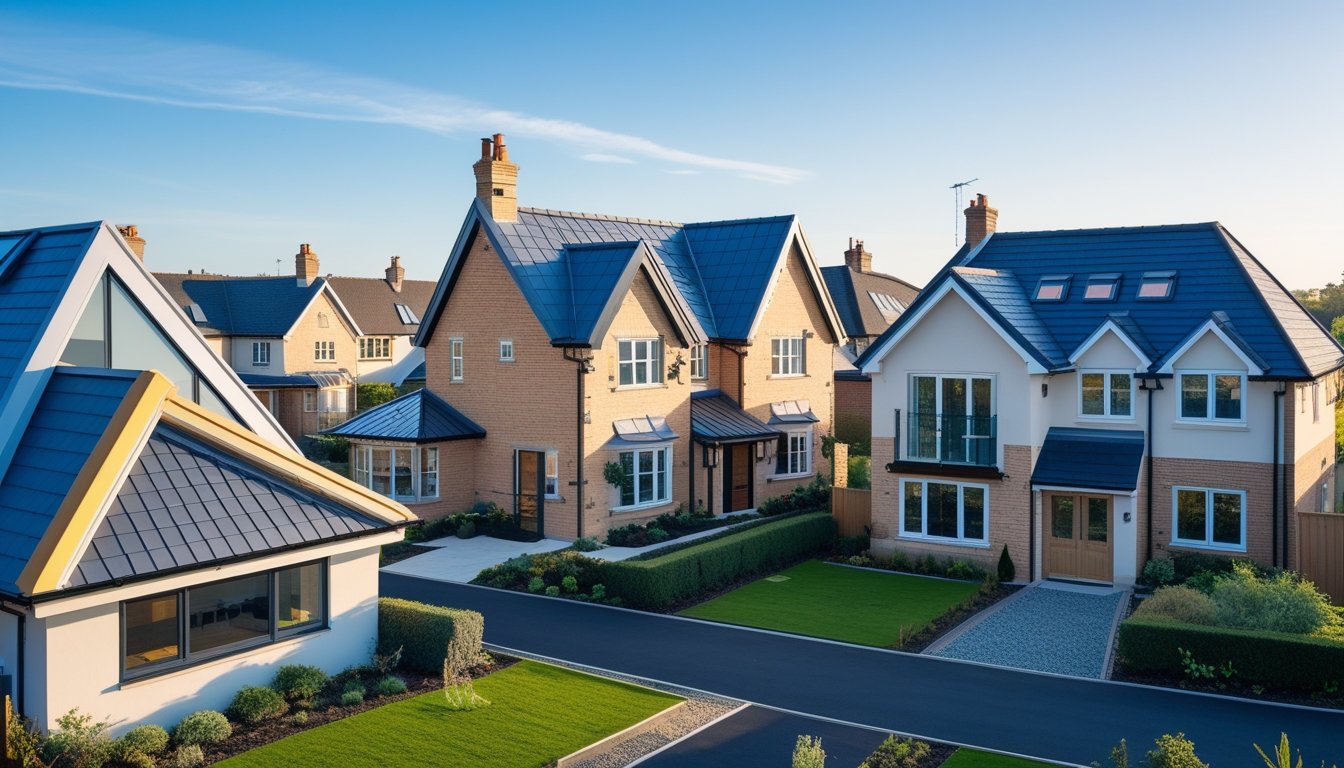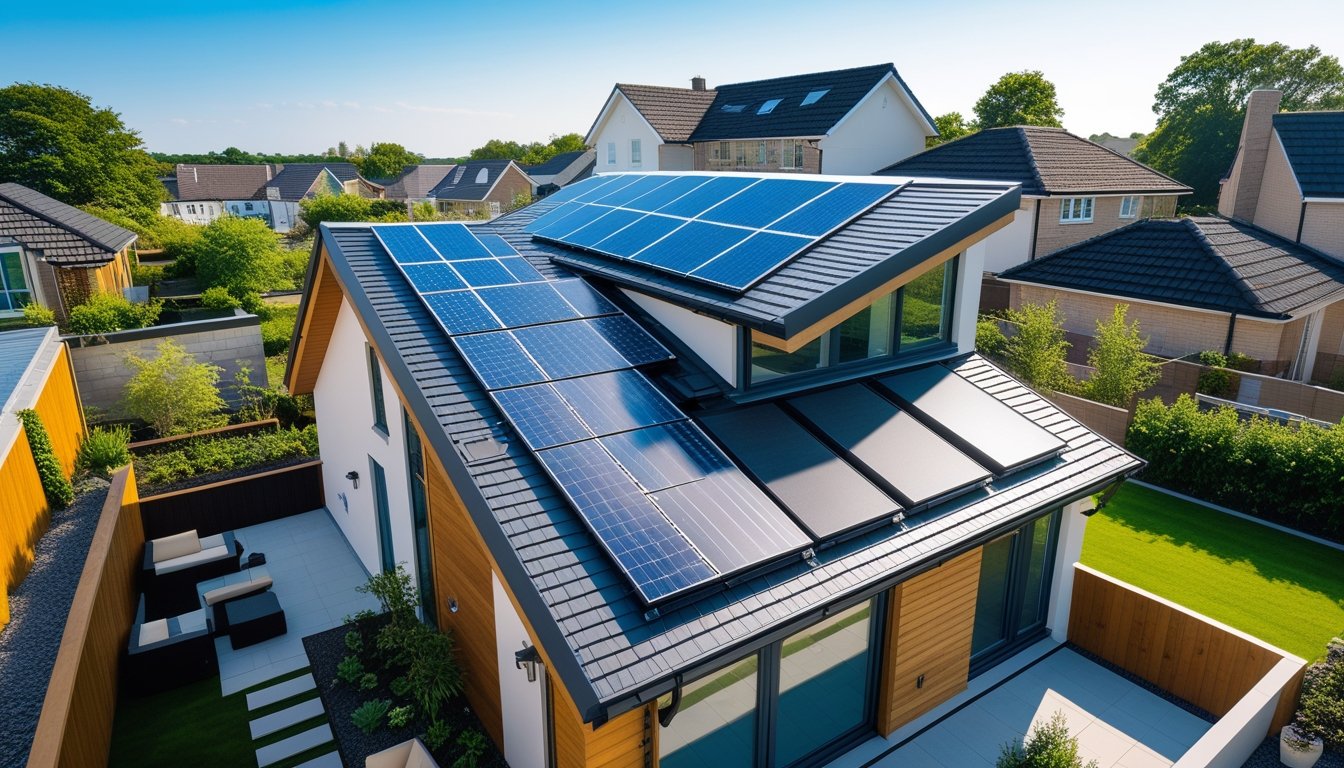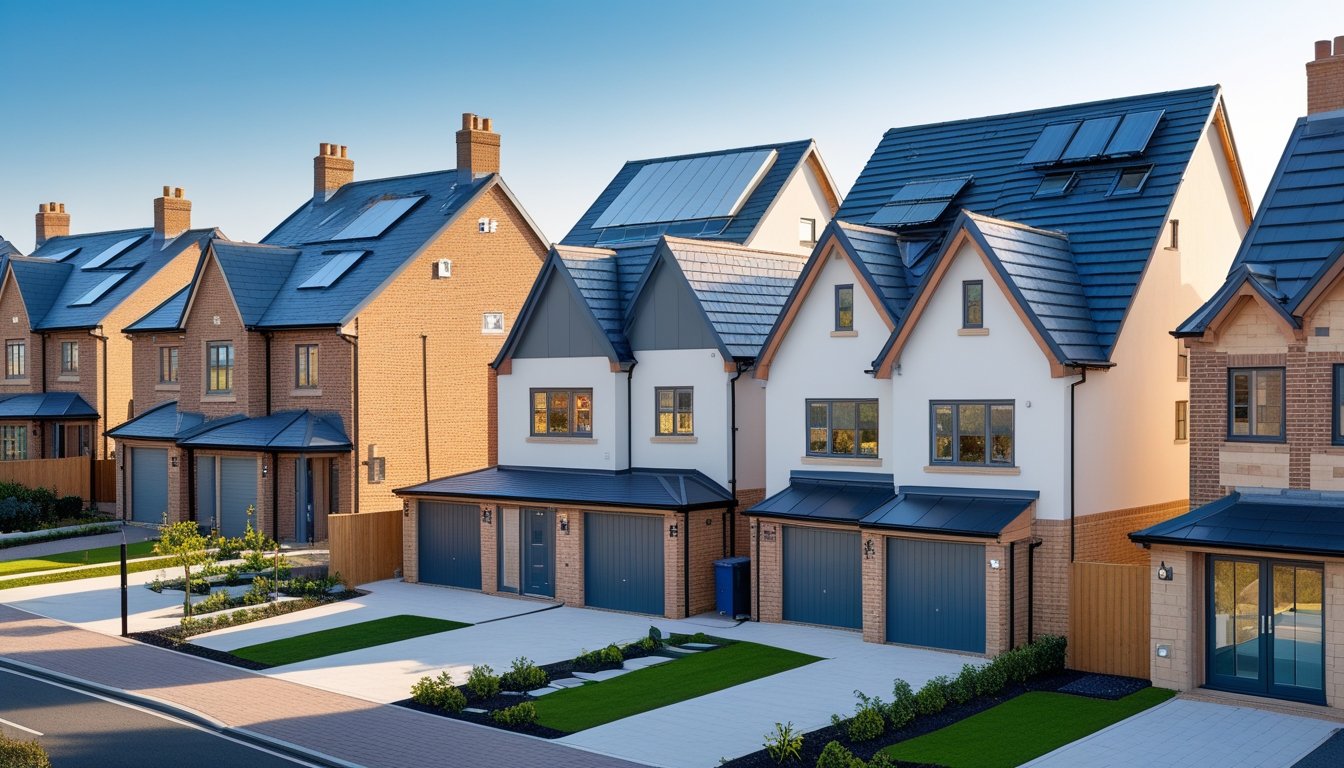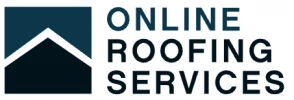Late updated: 19 Aug 2025 10:08
Written by: Oliver Bennett
Innovative Pitched Roof Designs For UK Homes: Trends and Benefits
Pitched roofs remain a staple in UK architecture due to their classic appeal and functional benefits. They efficiently shed water and withstand various weather conditions, making them ideal for the UK's often rainy climate. As we explore innovative pitched roof designs, we uncover how modern materials and sustainable practices are transforming these traditional structures into contemporary masterpieces.

In our journey through these designs, we find that pitched roofs now serve as more than just a protective cover. They can dramatically enhance a home's aesthetics, increase natural light, and even create space for solar panels. The balance between classical and cutting-edge is creating a resurgence in their popularity, appealing to both traditionalists and modern architecture enthusiasts.
Our exploration into innovative pitched roof designs reveals a fusion of creativity and functionality. We will delve into diverse styles that challenge conventional perceptions while still leveraging the charm of sloped roofing.
Key Takeaways
- Modern pitched roofs offer both aesthetic and functional benefits.
- They are increasingly incorporating sustainable and contemporary features.
- The designs enhance versatility and align with modern architectural needs.
Core Elements of Innovative Pitched Roof Designs

In designing innovative pitched roofs for UK homes, modern styles, key materials, and functional benefits form the backbone of our approach. Each element contributes to aesthetics, durability, and suitability for the British climate.
Modern Pitched Roof Styles for UK Homes
Modern pitched roof styles in the UK incorporate a blend of tradition and innovation. Skillion roofs, with their sleek single slope, provide a contemporary aesthetic, ideal for urban settings.
Gable and hip roofs remain popular, but their designs now feature minimalist lines and eco-friendly features, enhancing both style and sustainability. Multi-faceted designs allow us to create unique architectural statements that accommodate solar panels effortlessly. These modern adaptations ensure roofs not only protect homes but also elevate them into striking visual features.
Key Materials and Construction Techniques
When it comes to materials, metal roofs are gaining traction due to their durability and low maintenance. Materials such as zinc, copper, and aluminium offer resilience in UK's variable weather.
Timber framing supports flexibility in design, allowing for both aesthetic and structural innovation. Enhanced insulation methods are being employed to improve energy efficiency.
Advanced construction techniques like prefabrication and modular assembly expedite building processes and ensure precision. These modern materials and techniques facilitate creative freedom while ensuring longevity and functionality.
Benefits of Pitched Roofs in British Climate
Pitched roofs are exceptionally suited to the British climate, offering effective water drainage which minimises the risk of water ingress during heavy rains. The slope of the roof allows snow to shed efficiently, reducing structural load.
Moreover, pitched roofs can improve insulation, keeping homes warmer during cold months and cooler during summer. They form an integral part of energy-saving designs, often accommodating solar panels.
In areas prone to wind, these roofs provide structural stability. Altogether, pitched roofs integrate aesthetic appeal with practical functionality, making them a preferred choice for many UK homeowners.
Sustainable and Contemporary Features for Pitched Roofs

Modern pitched roofs are at the forefront of architectural design, combining sustainability with innovation. They help reduce energy consumption while enhancing the aesthetic appeal of buildings. Let us explore features such as solar panel integration, eco-friendly materials, and innovative lighting solutions that make these roofs optimal for modern homes.
Integrating Solar Panels and Skylights
Installing solar panels on pitched roofs is an effective way to harness renewable energy. Positioned to catch maximum sunlight, they significantly cut energy costs and reduce carbon footprints. Skylights complement solar panels by improving natural light within the house. They not only enhance indoor ambiance but also further reduce reliance on artificial lighting during daylight hours.
Proper installation is crucial for both solar panels and skylights to ensure they are optimally functional. Careful planning regarding placement and orientation can result in enhanced energy efficiency. Together, these features elevate the environmental friendliness of homes, making them both modern and practical.
Eco-Friendly Roofing Materials and Sustainability
Choosing eco-friendly roofing materials is essential for sustainability. Options like recycled shingles, reclaimed wood, and slate give roofs a contemporary look while minimising ecological impact. These materials are durable, reducing the need for frequent replacement and conserving resources.
An emphasis on sustainability extends to the manufacturing process, where energy-efficient methods are preferred. Rainwater collection systems integrated into the design further enhance eco-friendliness. Overall, using environmentally responsible materials ensures that these roofs align with the principles of conservation and sustainability.
Maximising Natural Light With Large Windows
Large windows in conjunction with pitched roofs offer homeowners ample natural light, reducing electricity usage. Placed strategically, they can form a seamless transition from interior to exterior, providing expansive outdoor views. The combination of large windows with skylights optimises the house’s natural lighting conditions.
The design needs to consider the balance between light and heat. Using double-glazed or low-emissivity glass can prevent excessive heat gain in summer while retaining warmth in winter. This energy-efficient approach allows homes to remain bright and inviting throughout the year.
Exploring Metal and Copper Roofing Options
Metal roofing has been a staple for modern homes, with materials like copper and steel offering durability and aesthetic appeal. Copper, in particular, is valued for its longevity and distinctive appearance, which develops a patina over time. It is sustainable and recyclable, aligning well with environmentally conscious designs.
Using metals for roofing offers benefits such as fire resistance and low maintenance. They reflect sunlight, reducing cooling costs in warmer months. Proper insulation and ventilation beneath metal roofs help maintain comfortable indoor temperatures. Metal roofs thus present a blend of strength, modernity, and sustainability, making them a suitable choice for today’s homes.
Frequently Asked Questions

Our exploration of pitched roof designs touches on the latest trends, materials, and considerations for UK homes. From adapting traditional gable roofs to incorporating solar technology, such innovations have reshaped both the aesthetics and functionality of residential properties.
What are the latest trends in modern pitched roof designs for residential properties?
Modern pitched roof designs incorporate sustainable technologies and advanced materials, offering both visual appeal and functionality. Metal roofs, for instance, are making a comeback due to their durability and attractive appearance. These new designs seamlessly blend aesthetics with practical benefits.
How can gable roofs be adapted to suit contemporary UK homes?
Gable roofs, known for their simple structure and effective water drainage, can be tailored for modern homes by using unique materials and incorporating energy-efficient elements. These adaptations make them both visually appealing and suited to contemporary architectural styles.
What materials are best suited for constructing durable and aesthetically pleasing pitched roofs?
The choice of materials significantly impacts the durability and appearance of pitched roofs. Options like terracotta tiles, slate, and metal panels offer different advantages in terms of strength, weather resistance, and aesthetic value. These materials blend tradition with modern requirements.
Are there any innovative solutions for integrating solar panels into pitched roof designs?
Innovations in solar technology allow solar panels to be seamlessly integrated into the design of pitched roofs. In-roof systems are a preferred choice, as they install flush with the roof's surface, maintaining a sleek appearance while enhancing energy efficiency.
What are the planning considerations for modifying the roofline in a UK home?
When altering a roofline, it's essential to think about planning permissions, structural integrity, and the overall impact on the building's appearance. Regulations may vary, so consulting local planning authorities ensures compliance and helps maintain architectural harmony with the surroundings.
How can pitched roofs contribute to improved energy efficiency in residential buildings?
Pitched roofs enhance energy efficiency, primarily through better insulation and ventilation. The sloped design promotes air circulation, which can reduce heating and cooling costs. Integrating energy-efficient materials into the construction further supports sustainable living.
